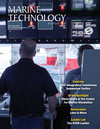
Page 37: of Marine Technology Magazine (July 2024)
Read this page in Pdf, Flash or Html5 edition of July 2024 Marine Technology Magazine
Vehicle endurance would also be a factor in the number of
UUVs required to maintain persistent, wide area coverage, as recovery and recharging will impact on-station time. The
Remus 600 can operate for approximately 70 hours, but this will vary depending on battery loadout and the power require- ments of its sensor/effector payload and onboard process- ing. Unless there are stowage modi? cations, each TTL UUV would displace a weapon, which in peacetime may make little difference, but would be a serious consideration should war break out. One workaround could be a system that leverages the ? exibility of Virginia-class payload tubes, such as the Uni- versal Launch and Retrieval Module from General Dynamics, which utilizes a retractable platform to deploy and recover
UUVs of varying displacements.
Whereas in the past, submarines have relied on passive sonar and stealth when carrying out their missions, continued suc- cess – and survivability - will hinge on how artfully new tech- nologies and unmanned systems can be integrated into subsea operations. It will also necessitate a more aggressive posture, whether targeting enemy submarines using offboard active sonar, neutralizing seabed targets, laying mine? elds at stand- off range, or deceiving and disrupting enemy ASW. Onboard integration of UUVs will greatly enhance these mission sets and others yet to be conceived, making submarines even more capable sensor/effector platforms, and prompting the develop- ment of innovative submarine tactics, techniques, and proce- dures to meet the challenges of tomorrow’s undersea domain.
www.marinetechnologynews.com
MTR #5 (34-47).indd 37 7/25/2024 10:23:46 AM

 36
36

 38
38
